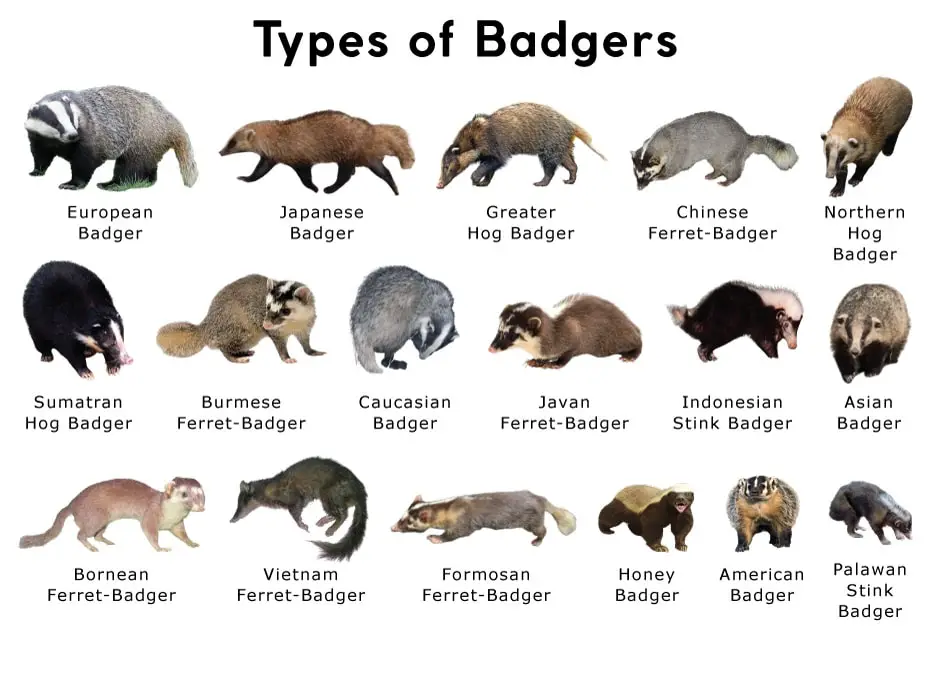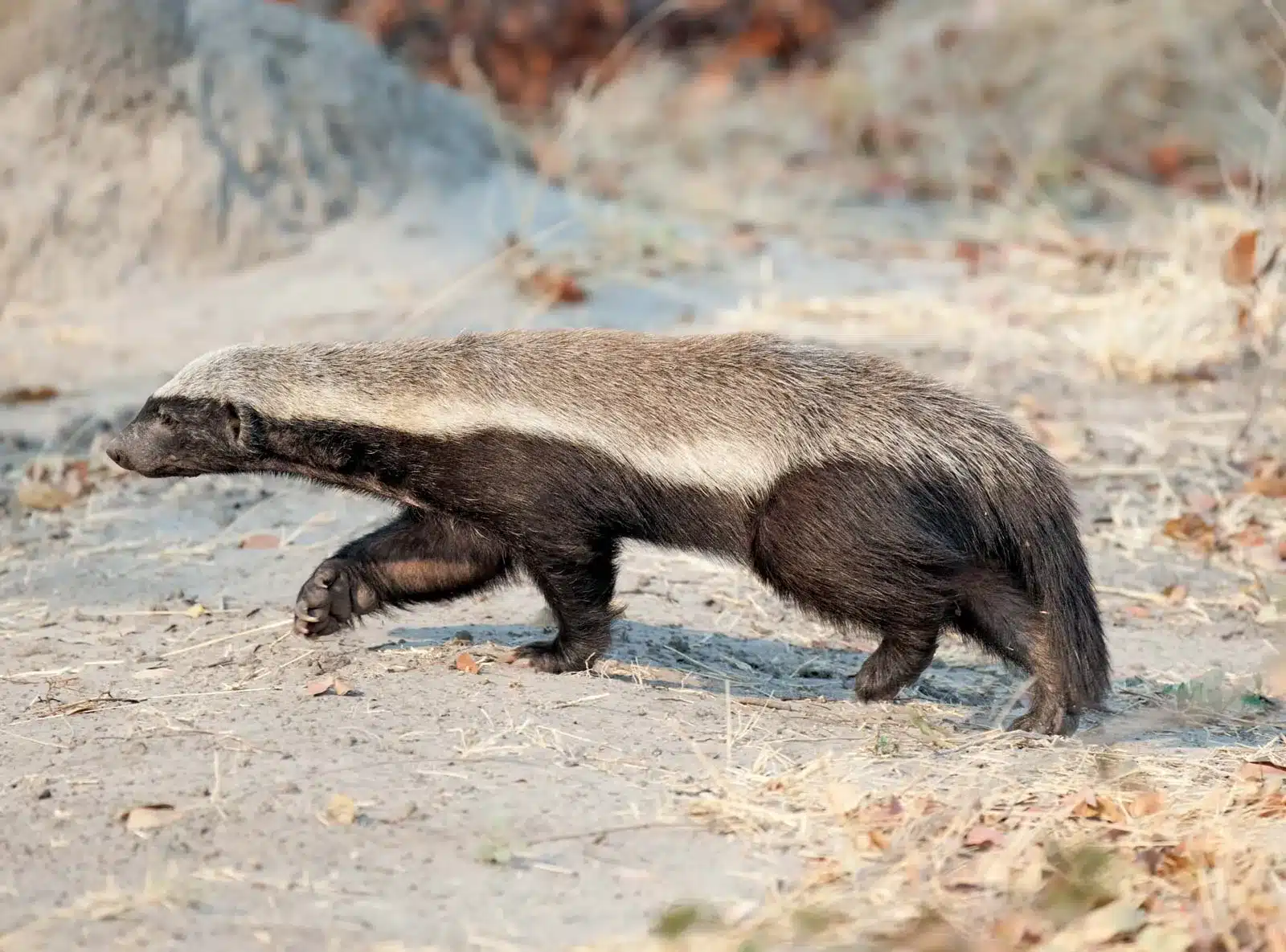Badgers
Badgers are strong and dangerous animals known for their complex nature. They are medium-sized, unique mammals with tiny legs. They belong to a Mustelidae family in which wolverines, otters, weasels, and minks exist. They use their best tactics at night, diggingburrows to create intricate tunnels. These adorable white-striped mammals are found all over the world.
Scientific Classification of Badgers
Kingdom | Animalia |
Phylum | Chordata |
Class | Mammalia |
Order | Carnivora |
Suborder | Caniformia |
Family | Mustelidae |
Different Species of Badgers
Mustelidae is further divided into 4 sub-families in which eleven species of badgers are present under the given genera. Two species of badger are from the mephitidae family. From melinae to taxidiinae, they are nature’s best creatures.
Sub-families | Species |
Taxideinae | American badger (Taxidea taxus) |
Mellivorinae | Honey badger (Mellivora capensis) |
Melinae |
|
Helictidinae |
|

Physical Characteristics
Size and weight: Badger’s size and weight vary between species. European and ferret badgers are large and small respectively. They are 60 to 90 meters in length. Females are lighter than males. Badgers weigh between 6 to 20kg. On average, an adult female weighs 24 pounds, while the male weighs 17.
Strips: Badgers are striped mammals. They have white strips on their heads with black markings. Their white and black stripes passing from head to nose signal fierceness.
Speed: Badgers are high-paced animals. They cover 20 miles per hour when hunting. They are good at climbing and baiting.
Body and tail: They are sturdy animals with broad, flattened bodies and small, elongated, flattened heads. Their neck, ears, and limbs are short. Badgers’ bellies are light in colour, and their legs are dark. Tails of male badgers are thin, while female tails are short and bushy. Their tails are 10 to 30 cm long.
Coat colouration: Their coat colours vary in species. Badgers’ bodies are black, white, brown and grey, with white and black stripes on their heads. Hog badgers are grey and brown with dark eye circles. Honey badgers coats are grey from head to back, and their feet, faces and underbellies are black. Their coat colouration helps them in camouflage.

Badgers Size and Weight

Badger Strips

Head and Horns
Distribution and Habitat
These adorable creatures are distributed around the world. They are found in Asia, Europe, Scandinavia, North America, Britain, China, Japan, Korea, Indonesia, Malaysia, and Ireland. Honey badgers exist from Pakistan and India to the Levant, from the Arabian desert to sub-Saharan Africa.
Badgers inhabit dry areas, such as open forests and semi-deserts. They prefer to live in meadows, orchards, plains, farmlands and woodlands. Badgers love to live in moist areas rather than water. They spend their nights in burrows or tunnels in winter. They maintain their habitat well by living in open environments. Badgers are adaptable and can survive in different environments.
Diet and Digestion
Badgers are omnivores. They eat hundreds of earthworms at night as a staple food. The diet of badgers varies in species. They prey on insects, invertebrates and reptiles. Moreover, they eat a healthy diet, including apples, pears, plums and elderberries. Some mammals prey on squirrels, mice, voles, gophers, and prairie dogs.
The metabolic rate of badgers is high. Badgers preserve high amount of fat in their bodies for late autumn and summer. In winter, they spend their nights at ease in a network of tunnels.
Badgers as a Source of Meat
In the Altai Region of Russia, badger meat is consumed as Shish Kebabs. In France, badger meat was utilized in many dishes. Britains consume a lot of badgers meat during World War 2. In Croatia, badger meat is dried and smoked before serving.

Behavioral adaptations
Social Behaviour
Badgers make colonies in which they spend their lives called Clans. In North America, adult badgers, including male and female, are called Kits. The European badger is the most giant badger of all. The male and female are known as Boar and Sow, respectively. Their young are known as Cubs. They form social groups by making underground tunnels. The tunnels that badgers create are called setts. They mark their territory or sett through piles of latrines.
Hunting
Many mammals are solid and muscular, but badgers’ vigour is unique. Sometimes, they hunt alone or in cooperation with coyotes. Without any hesitation, they kill snakes and digest them. They hunt gophers, squirrels, small mammals, insects and birds. Due to their strong olfactory sense, they detect predators and secure their species.
Burrowing Behaviour
Badger’s digging performance is top-notch. They are fierce mammals and have front-solid claws to assist in capturing prey. They dug holes at night, organized tunnels and spent their time. Tunnels help them to secure themselves from predators. They feed a large amount of earthworms at night. Above all, American and Honey Badgers are skilled swimmers.
Communication and Flatulence
Badgers release their scent glands, which are symbols of communication and warning. Badgers produce different vocalizations of growls, purrs, and snorts when angry, afraid or happy. They produce smell fluid by lifting and dipping their tails through the squat marking technique. They mark their territories by defecating scent glands.
Camouflage
Camouflage is the adaptability of a habitat. Badgers are skilled animals, and they are protected from predators by camouflaging them. They have contract patterns that escape them from enemies. Their greyish, black and brown bodies are camouflaged with woodlands, meadows and grasslands.
Reproduction and Parenting
Badgers are mammals and live in open areas. But at the time of mating, they use their den to conceive. Their gestation period is about 6 weeks, but their zygote implantation is delayed. They mate during summer and autumn when they are fasting. Females become sexually mature or able to breed in the first year, while males are in the second year of life.
They give birth to 2 to 5 cubs at a time. The eyes of badgers are closed at the time of birth. After one month, they open their eyes. Female badgers care for their cubs when they are not fully prepared for hunting. The mother brings up their cubs in burrows, where they protect them from predators. Cubs are out of the den at 2 years old, when they can hunt,
Mortality rate and Lifespan
The natural predators of badgers are bobcats, cougars, golden eagles, wolves, and bears. They often prey on the young badgers. Therefore, the mortality rate of badgers is high in the cubs in the early years. Life expectancy exceeds six years of birth. The Lifespan of these quick mammals is 14 years in the wild. It exceeds 25 years in captivity.
Ecological Importance
Badgers are the big personalities with prominent families. They are expert foragers. They consume many seeds, which defecation helps in seed dispersal. The habit of nocturnal digging and making tunnels is helping to improve soil quality. They are ecologically essential for us because they reduce the population of rodents and insects.
Conservation Status and Efforts
Badgers face threats to humans and few natural enemies. The hunting of badgers is common in many countries for sport purposes. In England, the dachshund dog was used to hunt badgers. However, in 1835, the Cruelty to Animals Act and 1992, the Protection of Badgers Act banned badgers hunting.
It is not easy to secure them. Their coats are used in Scottish clothing and for medicinal purposes. American badgers hunt to make paint brushes, while other coats are used in shaving brushes. They are suffering from human-badgers conflict. By taking decisive action and making laws, it is possible to save badger species.
Badger Fun Facts
- Badgers are skilled hunters and create a network of underground burrows.
- They have a 700-times stronger smelling sense than humans, which allows them to detect predators at night.
- Their unique characteristic is their poop behaviour.
- Badgers are small but have more muscular bodies and claws, which helps them dig.
- Some badgers live alone or in separate places, while some spend their lives in groups.
- Badgers are immune to snake venom, they bite and devour snakes including black mambas and cobras.

Cultural Value
Badgers hold great importance in many cultures. Badgers are featured in novels, stories, folklore, and movies in literature.
- John Clare wrote a poem in the 19th century “The Badger” describing badger baiting and hunting.
- “The Chronicles of Narnia” by Clive Staples Lewis, is a fantasy novel in which a truffle hunter is a heroic badger.
- In Hogwarts School of Wizardry, the badger is pictured as an emblem of Hufflepuff in “The Harry Potter book series by Joanne Rowling.”
- Badgers are traditionally essential for Africa, Asia, and Europe where they are used as medicine.
FAQs- Frequently Asked Questions
What do badgers eat?
Badgers are omnivores, eating a diet that includes insects, small mammals, fruits, and roots.
Where do badgers live?
Badgers typically live in forests, grasslands, and hedgerows, where they dig burrows called setts.
Are badgers dangerous to humans?
Badgers are generally shy and avoid humans; however, they can defend themselves if threatened.
How do badgers communicate?
Badgers communicate using vocalizations, scent markings, and body language.
What is a group of badgers called?
A group of badgers is known as a “cete.”
Do badgers hibernate?
Badgers do not hibernate; they remain active throughout the year but may reduce activity in cold weather.
How long do badgers live?
In the wild, badgers typically live 4 to 6 years, though they can live longer in protected environments.
Are badgers friendly to humans?
Badgers are generally shy and elusive; they are not known for being friendly to humans and prefer to avoid contact.
What is badger slang for?
In slang, “badger” can refer to someone who persistently annoys or bothers others, derived from the animal’s tenacity.
What are badgers known for?
Badgers are known for their distinctive digging behavior, strong claws, and their complex burrow systems called setts.
Is a badger an aggressive animal?
Badgers can be aggressive if threatened, using their strong jaws and claws to defend themselves.
What eats badgers?
Predators of badgers include foxes, wolves, and occasionally large birds of prey.
What is badger used for?
Historically, badger fur has been used for making brushes, and in some cultures, badgers have been hunted for their meat.
Are badgers useful?
Badgers play a role in their ecosystems by controlling insect populations and creating burrows that benefit other wildlife.
Are badgers peaceful?
Badgers are generally peaceful but can become aggressive if their territory is threatened or if they are cornered.
Can a badger be a pet?
Badgers are wild animals and are not suitable to be kept as pets due to their specialized care needs and potential aggression.
Are badgers harmful?
Badgers can be harmful if provoked, as they have powerful claws and sharp teeth for defense.
Why are badgers so fearless?
Badgers are fearless due to their physical strength, defensive adaptations, and their role as apex predators in their environments.
Could a human fight a badger?
While a badger is formidable due to its aggression and strength, it is not advisable for a human to engage in physical conflict with one.
Learn More About Badgers
Welcome to our page dedicated to the fascinating behaviors of badgers. Here, you’ll find articles that answer common questions about these elusive creatures, such as their diet, activity patterns, reproductive habits, and their interactions with their environment and other species.
Scroll down to explore the unique behaviors of badgers and uncover the reasons behind their intriguing actions.

American badger
Introduction The American badger (Taxidea taxus) is a fierce and resilient predator known for its burrowing abilities. For more about
